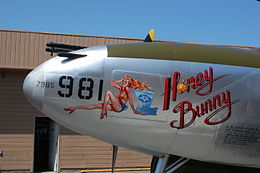
Back Nose art German Nose art Spanish نوز آرت Persian Nose art French Nose art Italian ノーズアート Japanese Nose art Portuguese Nose art Russian Носарт Ukrainian 機頭藝術 Chinese


Nose art is a decorative painting or design on the fuselage of an aircraft, usually on the front fuselage.
While begun for practical reasons of identifying friendly units, the practice evolved to express the individuality often constrained by the uniformity of the military, to evoke memories of home and peacetime life, and as a kind of psychological protection against the stresses of war and the probability of death. The appeal, in part, came from nose art not being officially approved, even when the regulations against it were not enforced.[2][3]
Because of its individual and unofficial nature, it is considered folk art, inseparable from work as well as representative of a group.[2] It can also be compared to sophisticated graffiti. In both cases, the artist is often anonymous, and the art itself is ephemeral. In addition, it relies on materials immediately available.[2]
Nose art is largely a military tradition, but civilian airliners operated by the Virgin Group feature "Virgin Girls" on the nose as part of their livery. In a broad sense, the tail art of several airlines such as the Eskimo of Alaska Airlines can be called "nose art", as are the tail markings of present-day U.S. Navy squadrons. There were exceptions, including the VIII Bomber Command, 301st Bomb Group B-17F "Whizzer", which had its girl-riding-a-bomb on the dorsal fin.[4]
- ^ "Flying high for 34 years – 10 facts about our flying lady nose art | Stories | Virgin Atlantic". flywith.virginatlantic.com. Retrieved 2024-02-21.
- ^ a b c Cite error: The named reference
parentseyeswas invoked but never defined (see the help page). - ^ Ethell, Jeffrey L. (1991). The History of Aircraft Nose Art: World War I to Today. Osceola, Wisconsin: Motorbooks International, p. 14.
- ^ Bowers, Peter M. (1976). Fortress In The Sky, Granada Hills, CA: Sentry Books. ISBN 0-913194-04-2, p. 219.